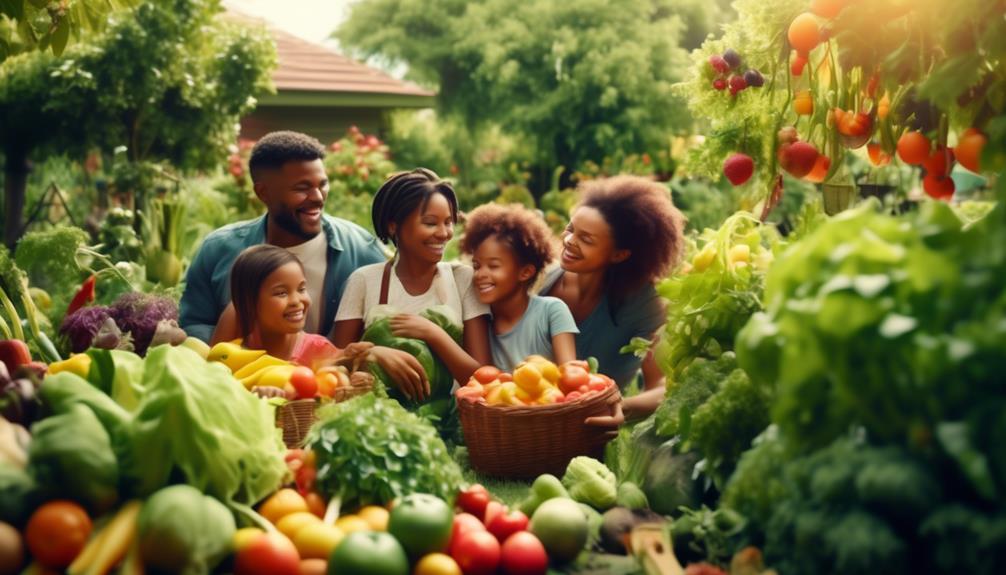Cultivating a Garden: A Family Project for Better Nutrition

Cultivating a garden as a family project promotes better nutrition.
It also promotes bonding while teaching children about the importance of nutritious food.
Benefits of Gardening as a Family
Gardening as a family brings numerous benefits, fostering a sense of responsibility and excitement in children as they actively participate in every step of the process, from planting to harvesting. It's a wonderful way to teach children about the importance of nutrition while instilling valuable life skills. When kids are involved in growing their own food, they become more invested in what they eat. Taste testing fresh fruits and vegetables from the garden can expand their palates and encourage healthy eating habits. Imagine the joy on their faces when they bite into a juicy tomato they helped grow or enjoy a salad made from their freshly picked lettuce.
Growing herbs as a family is a great way to introduce kids to gardening. It's easy and educational, with the added bonus of having fresh herbs for cooking. Children can learn about the different types of herbs, their flavors, and how to use them in meals. This hands-on experience not only teaches them about plants, but also enhances their culinary skills and creativity in the kitchen.
Starting with quick-growing plants like salad greens, carrots, and tomatoes is a fantastic way to keep children engaged. They can witness the results of their efforts more quickly, boosting their confidence and enthusiasm. This immediate gratification teaches them the value of hard work and patience.
Getting Kids Involved in Gardening
To get kids actively involved in the gardening process, assign them tasks such as watering, harvesting, or weeding. Not only will this teach them responsibility, but it will also foster a hands-on connection with the plants they're growing.
For preschoolers, let them explore dirt, dig holes, plant seeds, and work with the garden hose. This will give them a sense of ownership and allow them to experience the joy of gardening firsthand. To pique their interest, suggest fun plants like purple carrots and striped beets. Encourage them to try new vegetables and get excited about tasting the fruits of their labor.
For older children, involve them in every step of the gardening process. Teach them about seed packets, growing regions, and plant development. This will enhance their understanding of gardening and nutrition. Additionally, consider starting school gardens where kids and adults can work together. These gardens not only serve as a valuable educational tool, but they also promote teamwork and community involvement.
Encouraging Healthy Eating Through Taste Testing
As you continue to engage children in the gardening process, now let's explore how taste testing can encourage healthy eating habits and expand their preferences for fresh produce.
Encouraging healthy eating through taste testing is a fun and effective way to introduce kids to new fruits and vegetables. By involving them in the process, they can develop a positive relationship with fresh produce and expand their palate.
Taste testing allows children to experience the different flavors and textures of fruits and vegetables firsthand. It helps them understand that healthy food can be delicious too. By trying a variety of produce from the garden, kids can discover their personal preferences and develop a taste for nutritious foods.
To make taste testing a successful activity, you can create a fun and engaging environment. Set up a tasting station with different fruits and vegetables for kids to sample. Encourage them to describe the taste, texture, and overall experience of each food. You can also involve them in the preparation process, such as washing and cutting the produce.
Introducing kids to fruits and vegetables in various dishes is another way to encourage healthy eating. By incorporating fresh produce into their favorite meals, you can show them that healthy food can be tasty and enjoyable.
Growing Herbs for Added Nutrition
When it comes to growing herbs for added nutrition, there are several health benefits to consider.
Herbs like parsley, basil, and rosemary not only add flavor to your meals, but they also provide valuable nutrients.
Growing herbs in your garden is easy and low maintenance, making it a great starting point for both kids and adults alike.
Plus, with the ability to dry and store excess herbs, you can enjoy their flavors all year round.
Health Benefits of Herbs
Growing herbs in your garden is a practical and rewarding way to enhance the nutritional value of your meals. Not only are herbs easy to grow, but they also offer a plethora of health benefits. Here are three reasons why incorporating herbs into your meals can be beneficial for your health:
- Fresh and dried herbs: Herbs can be used fresh or dried, giving you the flexibility to use them in various recipes. Fresh herbs like parsley, basil, and rosemary are rich in vitamins and minerals, while dried herbs can be stored for longer periods and still retain their flavor and nutritional value.
- Flavor enhancement: Adding herbs to your dishes not only enhances the taste but also adds important nutrients. For example, basil is packed with antioxidants, parsley is a great source of vitamin K, and rosemary contains anti-inflammatory compounds.
- Easy access to nutritious ingredients: Cultivating herbs at home allows you to have easy access to fresh, flavorful, and nutritious ingredients. You can simply step out to your garden and pluck the herbs you need for your meals, ensuring that you're using the freshest and healthiest ingredients possible.
Easy-To-Grow Herbs
To continue enhancing the nutritional value of your meals, let's explore the world of easy-to-grow herbs that can be a valuable addition to your garden project.
Growing herbs not only adds flavor to your dishes, but it also provides numerous health benefits. Herbs like parsley, basil, and rosemary are excellent choices for beginners. They require minimal care and can thrive in small spaces.
The excess basil can be made into pesto and stored in the freezer for future use. Additionally, all herbs can be dried and preserved for later use, ensuring a year-round supply of fresh flavors.
By growing these herbs in your garden, you can easily incorporate them into your everyday meals, boosting the nutritional content and making your dishes even more delicious.
Using Herbs in Cooking
Enhance the flavor and nutritional value of your meals by incorporating fresh herbs grown in your own garden. Not only are herbs easy to grow, but they can also be a fantastic way to introduce your kids to gardening and nutrition.
Here are some practical tips for using herbs in your cooking:
- Choose herbs like parsley, basil, or rosemary to add a burst of flavor and nutrition to your dishes.
- If you have an abundance of basil, make pesto and store it in the freezer for later use.
- Don't let your excess herbs go to waste – dry them for future use. This will intensify their flavor and enhance the nutritional value of your meals.
Starting Small With Quick-Growing Plants
When it comes to starting a garden with quick-growing plants, there are several options to consider. Salad greens, carrots, and cucumbers are all great choices that are ideal for a kid-friendly garden.
These crops grow rapidly, which keeps kids engaged and excited about gardening. By starting small with these fast-growing plants, you can show children the results of their efforts quickly and keep them motivated to continue their gardening journey.
Fast-Growing Plant Options
For a successful kid-friendly garden, consider starting small with quick-growing plant options like salad greens, carrots, tomatoes, and cucumbers. These plants aren't only easy to grow, but they also provide a great opportunity for kids to learn about gardening and enjoy the fruits of their labor.
Here are three fast-growing plant options that will keep your little ones engaged and excited about their garden:
- Green beans: Kids will love watching these vines grow and produce a bountiful harvest. Plus, they can be picked and eaten straight from the garden!
- Grape tomatoes: These bite-sized tomatoes are perfect for little hands and can be enjoyed in salads or as a healthy snack. They're also known for their fast-growing nature, which means your kids won't have to wait long to taste their first homegrown tomato.
- Sunflowers: Not only are sunflowers a fun addition to any garden, but their seeds can also be dried for future planting. Kids will be amazed at how tall these plants can grow and enjoy the process of watching the flowers bloom.
Benefits of Starting Small
Starting small with quick-growing plants in a kid-friendly garden offers numerous benefits that will keep your little ones engaged and excited about their gardening journey.
By choosing crops like salad greens, carrots, tomatoes, and cucumbers, your children will be able to see visible results rapidly. This is especially important in a school garden setting, where kids may have limited patience and attention spans.
Quick-growing plants such as green beans and grape tomatoes are great options as they maintain kids' interest in the gardening process. Additionally, sunflowers are a fun addition to the garden, and they can be dried for seeds, providing an engaging and educational experience.
Starting small with quick-growing plants not only allows children to see the fruits of their labor sooner but also fosters excitement and engagement in the gardening project.
Exploring What Grows Below Ground
To truly appreciate the wonders of gardening, take a moment to explore the hidden treasures that lie beneath the soil's surface. There's a whole world of delicious and nutritious foods that grow below ground, waiting to be discovered.
Here are some exciting facts about what grows below ground:
- Roots and tubers like carrots, beets, and potatoes are exciting to harvest and can be a treasure hunt for kids. Digging up these vegetables can be a fun and rewarding experience, as children uncover the colorful and tasty rewards hiding beneath the soil.
- Growing herbs like parsley, basil, and rosemary is easy and can be a good starting point for children in gardening. These aromatic herbs not only add flavor to meals but also provide numerous health benefits.
- Quick-growing plants such as salad greens, carrots, tomatoes, and cucumbers are ideal for keeping kids engaged and excited about the process. These vegetables grow relatively fast, allowing children to see the results of their efforts in a short amount of time.
Tips for Gardening in Small Spaces
Maximize your gardening potential even in small spaces with these practical tips.
When it comes to gardening in small spaces, there are several strategies you can employ to make the most of your garden project. One option is to utilize large pots on patios or porches. This allows you to grow a variety of vegetables such as tomatoes, salad greens, and cucumbers. These plants thrive in containers and can provide you with a bountiful harvest.
Another idea is to opt for herbs like parsley, basil, or rosemary. Not only are they easy to grow, but they can also be dried for later use, adding flavor to your meals all year round.
If you have children involved in your garden project, it's important to choose quick-growing plants that will keep their interest. Salad greens, carrots, tomatoes, and cucumbers are all great options. These plants grow rapidly and provide a sense of accomplishment for young gardeners. To make the gardening experience even more exciting for kids, incorporate fun and educational elements. Try growing extreme-sized vegetables or involving them in every step of the gardening process.
In small spaces, it's also important to make the most of limited square footage. Cherry tomato plants, butternut squash, and pumpkins are great choices as they're low-maintenance and fascinating for kids to watch. These plants can be trained to grow vertically, saving precious space.
With these tips, you can create a thriving garden even in small spaces, providing your family with fresh and nutritious produce.
Frequently Asked Questions
How Do I Plan a Garden to Feed My Family?
To plan a garden to feed your family, start by deciding what you want to grow and considering your space and climate. Then, choose crops that are nutritious and easy to grow. Finally, create a planting schedule and prepare the soil for a successful harvest.
How Gardening Can Improve Your Health?
Gardening benefits your health and nutrition in numerous ways. It increases access to fresh fruits and vegetables, promotes physical activity, reduces the risk of chronic diseases, and enhances mental well-being.
How Does Gardening Influence Our Access to Healthy Food?
Gardening influences your access to healthy food by providing a sustainable food source. It allows you to grow fresh fruits, vegetables, and herbs, which are rich in nutrients. Gardening also benefits your mental health by fostering a sense of accomplishment and connection to nature.
What Is It Called When You Grow Enough Crops to Feed Your Family?
When you grow enough crops to feed your family, it's called achieving self-sustainability in food production. It provides you with food security, allowing you to rely on your own crops to meet your family's nutritional needs.











